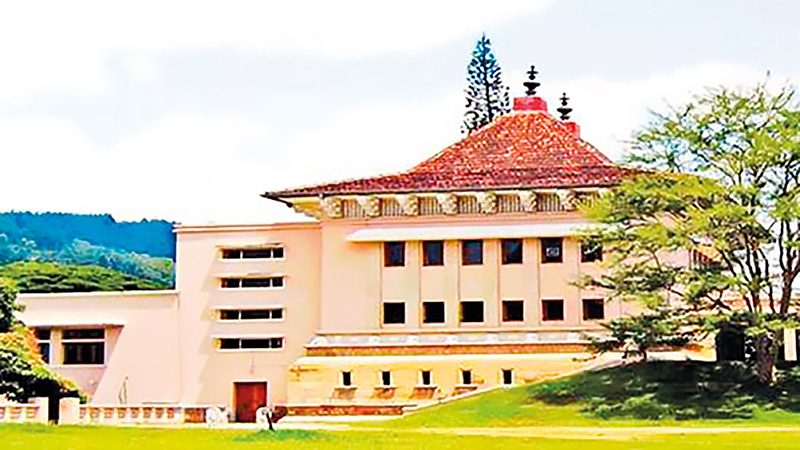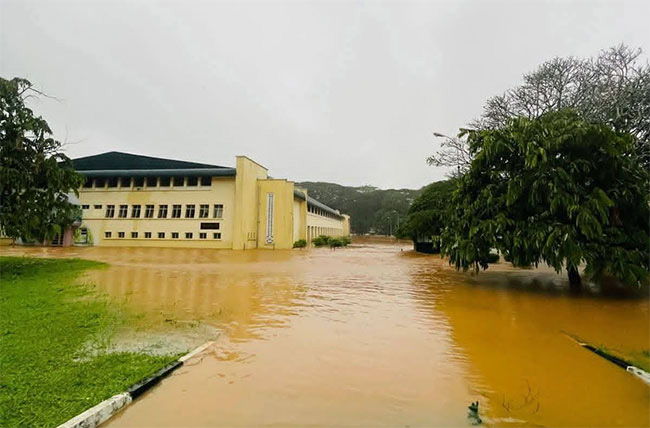Features
JRJ’s San Francisco speech that won Japan’s eternal gratitude

(Excepted from Men and Memories by JR Jayewardene)
I consider it a great privilege to be afforded the opportunity of placing before this Assembly of 51 nations the views of the Government of Ceylon on the Draft Treaty of Peace which we have been invited to approve of. My statement will consist of the reasons for our acceptance of this Treaty, and I shall also attempt to meet some of the criticisms that have been leveled against it.
It is true that I can speak only on behalf of my Government, but I claim that I can voice the sentiments of the people of Asia in their general attitude towards the future of Japan. I need not deal with the events that led to the formulation of the final Draft of the Treaty which we are considering. Mr (John Foster) Dulles, the American representative, and Mr Kenneth Younger, the British representative, have given us a full and fair account of those events, beginning with the capitulation of Japan in August 1945.
It may, however, be mentioned that there was a serious conflict of opinion between the four major powers as to the procedure that should be adopted to draft this Treaty. The Soviet Union insisting that the four major powers alone — that is, the Council of Foreign Ministers of the USA, UK, China and the USSR — should alone undertake it, and that the power of veto should be reserved to them if any others were admitted for the purpose of drafting the Treaty.
The United Kingdom insisted that the Dominion should be consulted, and the United States of America agreed with them. They also supported consultation with all the countries that took part in the war against Japan. Among these countries, too, there was a difference of opinion as to the actual terms of the Treaty actuated by various considerations, some by a fear of the rising of a new militaristic Japan, and others yet unable to forget the damage and the horrors caused by the Japanese invasions.
I venture to submit that it was at the Colombo Conference of Commonwealth Foreign Ministers held in January, 1950, that for the first time, the case for a completely Independent Japan was proposed and considered. The Colombo Conference considered Japan not as an isolated case, but as part of the region known as South and South-East Asia, containing a large proportion of the world’s wealth and population, and consisting of countries which have only recently regained their freedom, whose people were still suffering as a result of centuries of neglect.
Two ideas emerged from that Conference – one, that of an Independent Japan, and the other, the necessity for the economic and social development of the peoples of South and South-East Asia, to insure which what is now known as the Colombo Plan was launched.
Mr Kenneth Younger has explained how, after that Conference, a Working Committee of Commonwealth High Commissioners worked on a Draft Treaty, and later had consultations with the American representative, Mr Dulles.
The Treaty now before us is the result of those consultations and negotiations. It represents some of the views that my Government had, and some of them which it did not have. I claim that at the present moment it represents the largest common measure of agreement that could be attained among the countries that were willing to discuss peace with Japan.
The main idea that animated the Asian countries, Ceylon, India and Pakistan, in their attitude to Japan was that Japan should be free. I claim that this Treaty embodies that idea in its entirety. There are other matters which are external to the question of Japan’s freedom – namely, should that freedom be limited to the main Islands of Honshu, Hokkaido, Kyushu, and Shikoku, or should it extend to several minor Islands in the neighbourhood. If not, what should we do with those Islands? Should China be invited to the Peace Treaty Conference? If so, which government? Should reparations be exacted from Japan? If so, the amount. How is Japan to defend herself until she organizes her own defence?
On the main question of the freedom of Japan, we were able to agree ultimately, and the Treaty embodies that agreement. On the other matters, there were sharp differences of opinion, and the Treaty embodies the majority views. My Government would have preferred it if some of those questions were answered in a different way, but the fact that the majority don’t agree with us is no reason why we should abstain from signing the Treaty, which contains the central concept of a free and independent Japan.
We feel that the allied matters I mentioned earlier are not insoluble if Japan is free, that they are insoluble if Japan is not free. A free Japan, through, let us say, the United Nations organization, can discuss these problems with the other free nations of the world and arrive at early and satisfactory decisions. By signing this Treaty we are enabling Japan to be in a position to do so, to enter into a treaty of friendship with the Government of China which she decides to recognize, and I am happy to state, enabling her to enter into a Treaty of Peace and Friendship with India. If we do not sign this Treaty, none of those eventualities can take place.
Why is it that the peoples of Asia are anxious that Japan should be free? It is because of our age-long connections with her, and because of the high regard the subject peoples of Asia have for Japan when she alone, among the Asian nations, was strong and free and we looked up to her as a guardian and friend. I can recall incidents that occurred during the last War, when the co-prosperity slogan for Asia had its appeal to subject peoples, and some of the leaders of Burma, India and Indonesia joined the Japanese in the hope that thereby their beloved countries may be liberated.
We in Ceylon were fortunate that we were not invaded, but the damage caused by air raids, by the stationing of enormous armies under the South-East Asian command, and by the slaughter-tapping of one of our main commodities, rubber, when we were the only producer of natural rubber for the Allies, entitle us to ask that the damage so caused should be repaired.
We do not intend to do so, for we believe in the words of the great Teacher whose message has ennobled the lives of countless millions in Asia, that “hatred ceases not by hatred, but by love”. It is the message of the Buddha, the great Teacher, the founder of Buddhism, which spread a wave of humanism through South Asia, Burma, Laos, Cambodia, Siam, Indonesia and Ceylon, and also northwards through the Himalayas into Tibet, China, and finally, Japan, which bound us together for hundreds of years with a common culture and heritage.
This common culture still exists, as I found on my visit to Japan last week on my way to attend this Conference; and from the leaders of Japan, Ministers of State as well as private citizens, from their priests in the temples, I gathered the impression that the common people of Japan are still influenced by the shadow of that great teaching of Peace, and wish to follow it. We must give them that opportunity.
That. is why I cannot subscribe to the views of the delegate of the Soviet Union when he proposed that the freedom of Japan should be limited. The restrictions he wishes to impose, such as the limitation on the right of Japan to maintain such defence forces as a free nation is entitled to, and the other limitations she proposes, will make this Treaty not acceptable, not only to the vast majority of the delegates present here, but even to some of the countries that have not attended this Conference, particularly India, which wishes to go even further than this Treaty visualizes.
If again the Soviet Union wishes the Islands of Ryukyu and Bonin returned to Japan, contrary to the Cairo and Potsdam Declarations, why should then South Sakilin, as well as Kuriles be also not returned to Japan?
It is also interesting to note that the amendments of the Soviet Union seek to insure to the people of Japan the fundamental freedoms of expression, of press and publication, of religious worship, of political opinion and of public meeting – freedoms which the people of the Soviet Union themselves would dearly love to possess and enjoy. The reason why, therefore, we cannot agree to the amendments proposed by the Soviet delegate, is because this Treaty proposes to return to Japan sovereignty, equality and dignity, and we cannot do so if we give them with qualifications.
The purpose of the Treaty then is to make Japan free, to impose no restrictions on Japan’s recovery, to see to it that she organizes her own military defence against external aggression, and internal subversion, and that until she does so, she invites the aid of a friendly power to protect her and that no reparations be exacted from her that harm her economy.
This Treaty is as magnanimous as it is just to a defeated foe. We extend to Japan a hand of friendship, and trust that with the closing of this chapter in the history of Man, the last page of which we write today, and with the beginning of the new one, the first page of which we dictate tomorrow, her people and ours may march together to enjoy the full dignity of human life in peace and prosperity.
Thank you.
As I came out to the verandah during the lunch interval, I was mobbed by well-wishers who insisted on shaking me by the hand, and women of all ages who sought my autographs. It was with the help of a member of the American Security Police that I was able to join the rest of the delegation.
After my speech, the delegates of Pakistan, Laos and Cambodia supported the Treaty. “The voice of free Asia, eloquent, melancholy and strong with the lilt of an Oxford accent, dominated the Conference today”, said the New York Times of September 6.
On September 7 the speeches continued. Forty nine nations had announced their intention to sign the Treaty and their delegates had spoken at the Conference. The only attacks came from the woman delegate, Dr Sekavinova of Czechoslovakia, and Gromyko who spoke for a minute over the hour prescribed as the time limit.
Speculation was rife as to whether the Soviet Union and its supporters would sign the Treaty or leave the Conference. They were working in such close unison that any action by Gromyko who was sitting behind the other two delegations was immediately copied by them. On one occasion, when the debate was drawing to a close, Gromyko suddenly rose and left the hall walking down the aisle to the back entrances. All eyes were turned on him. Up jumped the woman Czech delegate and the Polish delegate, gathered their papers and walked swiftly out following Gromyko. They evidently thought this was a signal for a walk-out.
Later, when Gromyko returned and sat down in his seat,with a smile on his face for the first time, we learned that he had gone out to use the lavatory. The other two who had followed him returned rather sheepishly to their seats a little later. In the last stages of the debate the Polish delegate declared, “Those countries not under US dictatorship will not sign the Peace Treaty”, meaning thereby the Soviet Union, Czechoslovakia and Poland, though the Japanese Prime Minister in a dignified speech accepted the Peace Treaty as the best in the circumstances.
The Conference concluded according to schedule, on Saturday, September 8 morning, and watched by some 40 million people, a feat made possible by the inauguration of coast-to-coast and transcontinental television for the first time, 48 nations signed a treaty of peace with Japan and thus concluded a 10-year war and occupation.
Features
Rethinking post-disaster urban planning: Lessons from Peradeniya

A recent discussion by former Environment Minister, Eng. Patali Champika Ranawaka on the Derana 360 programme has reignited an important national conversation on how Sri Lanka plans, builds and rebuilds in the face of recurring disasters.
His observations, delivered with characteristic clarity and logic, went beyond the immediate causes of recent calamities and focused sharply on long-term solutions—particularly the urgent need for smarter land use and vertical housing development.
Ranawaka’s proposal to introduce multistoried housing schemes in the Gannoruwa area, as a way of reducing pressure on environmentally sensitive and disaster-prone zones, resonated strongly with urban planners and environmentalists alike.
It also echoed ideas that have been quietly discussed within academic and conservation circles for years but rarely translated into policy.
One such voice is that of Professor Siril Wijesundara, Research Professor at the National Institute of Fundamental Studies (NIFS) and former Director General of the Royal Botanic Gardens, Peradeniya, who believes that disasters are often “less acts of nature and more outcomes of poor planning.”
“What we repeatedly see in Sri Lanka is not merely natural disasters, but planning failures,” Professor Wijesundara told The Island.
“Floods, landslides and environmental degradation are intensified because we continue to build horizontally, encroaching on wetlands, forest margins and river reservations, instead of thinking vertically and strategically.”
The former Director General notes that the University of Peradeniya itself offers a compelling case study of both the problem and the solution. The main campus, already densely built and ecologically sensitive, continues to absorb new faculties, hostels and administrative buildings, placing immense pressure on green spaces and drainage systems.
“The Peradeniya campus was designed with landscape harmony in mind,” he said. “But over time, ad-hoc construction has compromised that vision. If development continues in the same manner, the campus will lose not only its aesthetic value but also its ecological resilience.”
Professor Wijesundara supports the idea of reorganising the Rajawatte area—located away from the congested core of the university—as a future development zone. Rather than expanding inward and fragmenting remaining open spaces, he argues that Rajawatte can be planned as a well-designed extension, integrating academic, residential and service infrastructure in a controlled manner.
Crucially, he stresses that such reorganisation must go hand in hand with social responsibility, particularly towards minor staff currently living in the Rajawatte area.
“These workers are the backbone of the university. Any development plan must ensure their dignity and wellbeing,” he said. “Providing them with modern, safe and affordable multistoried housing—especially near the railway line close to the old USO premises—would be both humane and practical.”
According to Professor Wijesundara, housing complexes built near existing transport corridors would reduce daily commuting stress, minimise traffic within the campus, and free up valuable land for planned academic use.
More importantly, vertical housing would significantly reduce the university’s physical footprint.
Drawing parallels with Ranawaka’s Gannoruwa proposal, he emphasised that vertical development is no longer optional for Sri Lanka.
“We are a small island with a growing population and shrinking safe land,” he warned.
“If we continue to spread out instead of building up, disasters will become more frequent and more deadly. Vertical housing, when done properly, is environmentally sound, economically efficient and socially just.”
The veteran botanist also highlighted the often-ignored link between disaster vulnerability and the destruction of green buffers.
“Every time we clear a lowland, a wetland or a forest patch for construction, we remove nature’s shock absorbers,” he said.
“The Royal Botanic Gardens has survived floods for over a century precisely because surrounding landscapes once absorbed excess water. Urban planning must learn from such ecological wisdom.”
Professor Wijesundara believes that universities, as centres of knowledge, should lead by example.
“If an institution like Peradeniya cannot demonstrate sustainable planning, how can we expect cities to do so?” he asked. “This is an opportunity to show that development and conservation are not enemies, but partners.”
As climate-induced disasters intensify across the country, voices like his—and proposals such as those articulated by Patali Champika Ranawaka—underscore a simple but urgent truth: Sri Lanka’s future safety depends not only on disaster response, but on how and where we build today.
The challenge now lies with policymakers and planners to move beyond television studio discussions and academic warnings, and translate these ideas into concrete, people-centred action.
By Ifham Nizam ✍️
Features
Superstition – Major barrier to learning and social advancement

At the initial stage of my six-year involvement in uplifting society through skill-based initiatives, particularly by promoting handicraft work and teaching students to think creatively and independently, my efforts were partially jeopardized by deep-rooted superstition and resistance to rational learning.
Superstitions exerted a deeply adverse impact by encouraging unquestioned belief, fear, and blind conformity instead of reasoning and evidence-based understanding. In society, superstition often sustains harmful practices, social discrimination, exploitation by self-styled godmen, and resistance to scientific or social reforms, thereby weakening rational decision-making and slowing progress. When such beliefs penetrate the educational environment, students gradually lose the habit of asking “why” and “how,” accepting explanations based on fate, omens, or divine intervention rather than observation and logic.
Initially, learners became hesitant to challenge me despite my wrong interpretation of any law, less capable of evaluating information critically, and more vulnerable to misinformation and pseudoscience. As a result, genuine efforts towards social upliftment were obstructed, and the transformative power of education, which could empower individuals economically and intellectually, was weakened by fear-driven beliefs that stood in direct opposition to progress and rational thought. In many communities, illnesses are still attributed to evil spirits or curses rather than treated as medical conditions. I have witnessed educated people postponing important decisions, marriages, journeys, even hospital admissions, because an astrologer predicted an “inauspicious” time, showing how fear governs rational minds.
While teaching students science and mathematics, I have clearly observed how superstition acts as a hidden barrier to learning, critical thinking, and intellectual confidence. Many students come to the classroom already conditioned to believe that success or failure depends on luck, planetary positions, or divine favour rather than effort, practice, and understanding, which directly contradicts the scientific spirit. I have seen students hesitate to perform experiments or solve numerical problems on certain “inauspicious” days.
In mathematics, some students label themselves as “weak by birth”, which creates fear and anxiety even before attempting a problem, turning a subject of logic into a source of emotional stress. In science classes, explanations based on natural laws sometimes clash with supernatural beliefs, and students struggle to accept evidence because it challenges what they were taught at home or in society. This conflict confuses young minds and prevents them from fully trusting experimentation, data, and proof.
Worse still, superstition nurtures dependency; students wait for miracles instead of practising problem-solving, revision, and conceptual clarity. Over time, this mindset damages curiosity, reduces confidence, and limits innovation, making science and mathematics appear difficult, frightening, or irrelevant. Many science teachers themselves do not sufficiently emphasise the need to question or ignore such irrational beliefs and often remain limited to textbook facts and exam-oriented learning, leaving little space to challenge superstition directly. When teachers avoid discussing superstition, they unintentionally reinforce the idea that scientific reasoning and superstitious beliefs can coexist.
To overcome superstition and effectively impose critical thinking among students, I have inculcated the process to create a classroom culture where questioning was encouraged and fear of being “wrong” was removed. Students were taught how to think, not what to think, by consistently using the scientific method—observation, hypothesis, experimentation, evidence, and conclusion—in both science and mathematics lessons. I have deliberately challenged superstitious beliefs through simple demonstrations and hands-on experiments that allow students to see cause-and-effect relationships for themselves, helping them replace belief with proof.
Many so-called “tantrik shows” that appear supernatural can be clearly explained and exposed through basic scientific principles, making them powerful tools to fight superstition among students. For example, acts where a tantrik places a hand or tongue briefly in fire without injury rely on short contact time, moisture on the skin, or low heat transfer from alcohol-based flames rather than divine power.
“Miracles” like ash or oil repeatedly appearing from hands or idols involve concealment or simple physical and chemical tricks. When these tricks are demonstrated openly in classrooms or science programmes and followed by clear scientific explanations, students quickly realise how easily perception can be deceived and why evidence, experimentation, and critical questioning are far more reliable than blind belief.
Linking concepts to daily life, such as explaining probability to counter ideas of luck, or biology to explain illness instead of supernatural causes, makes rational explanations relatable and convincing.
Another unique example that I faced in my life is presented here. About 10 years ago, when I entered my new house but did not organise traditional rituals that many consider essential for peace and prosperity as my relatives believed that without them prosperity would be blocked. Later on, I could not utilise the entire space of my newly purchased house for earning money, largely because I chose not to perform certain rituals.
While this decision may have limited my financial gains to some extent, I do not consider it a failure in the true sense. I feel deeply satisfied that my son and daughter have received proper education and are now well settled in their employment, which, to me, is a far greater achievement than any ritual-driven expectation of wealth. My belief has always been that a house should not merely be a source of income or superstition-bound anxiety, but a space with social purpose.
Instead of rituals, I strongly feel that the unused portion of my house should be devoted to running tutorials for poor and underprivileged students, where knowledge, critical thinking, and self-reliance can be nurtured. This conviction gives me inner peace and reinforces my faith that education and service to society are more meaningful measures of success than material profit alone.
Though I have succeeded to some extent, this success has not been complete due to the persistent influence of superstition.
by Dr Debapriya Mukherjee
Former Senior Scientist
Central Pollution Control Board, India ✍️
Features
Race hate and the need to re-visit the ‘Clash of Civilizations’

 Australian Prime Minister Anthony Albanese has done very well to speak-up against and outlaw race hate in the immediate aftermath of the recent cold-blooded gunning down of several civilians on Australia’s Bondi Beach. The perpetrators of the violence are believed to be ardent practitioners of religious and race hate and it is commendable that the Australian authorities have lost no time in clearly and unambiguously stating their opposition to the dastardly crimes in question.
Australian Prime Minister Anthony Albanese has done very well to speak-up against and outlaw race hate in the immediate aftermath of the recent cold-blooded gunning down of several civilians on Australia’s Bondi Beach. The perpetrators of the violence are believed to be ardent practitioners of religious and race hate and it is commendable that the Australian authorities have lost no time in clearly and unambiguously stating their opposition to the dastardly crimes in question.
The Australian Prime Minister is on record as stating in this connection: ‘ New laws will target those who spread hate, division and radicalization. The Home Affairs Minister will also be given new powers to cancel or refuse visas for those who spread hate and a new taskforce will be set up to ensure the education system prevents, tackles and properly responds to antisemitism.’
It is this promptness and single-mindedness to defeat race hate and other forms of identity-based animosities that are expected of democratic governments in particular world wide. For example, is Sri Lanka’s NPP government willing to follow the Australian example? To put the record straight, no past governments of Sri Lanka initiated concrete measures to stamp out the evil of race hate as well but the present Sri Lankan government which has pledged to end ethnic animosities needs to think and act vastly differently. Democratic and progressive opinion in Sri Lanka is waiting expectantly for the NPP government’ s positive response; ideally based on the Australian precedent to end race hate.
Meanwhile, it is apt to remember that inasmuch as those forces of terrorism that target white communities world wide need to be put down their counterpart forces among extremist whites need to be defeated as well. There could be no double standards on this divisive question of quashing race and religious hate, among democratic governments.
The question is invariably bound up with the matter of expeditiously and swiftly advancing democratic development in divided societies. To the extent to which a body politic is genuinely democratized, to the same degree would identity based animosities be effectively managed and even resolved once and for all. To the extent to which a society is deprived of democratic governance, correctly understood, to the same extent would it experience unmanageable identity-bred violence.
This has been Sri Lanka’s situation and generally it could be stated that it is to the degree to which Sri Lankan citizens are genuinely constitutionally empowered that the issue of race hate in their midst would prove manageable. Accordingly, democratic development is the pressing need.
While the dramatic blood-letting on Bondi Beach ought to have driven home to observers and commentators of world politics that the international community is yet to make any concrete progress in the direction of laying the basis for an end to identity-based extremism, the event should also impress on all concerned quarters that continued failure to address the matters at hand could prove fatal. The fact of the matter is that identity-based extremism is very much alive and well and that it could strike devastatingly at a time and place of its choosing.
It is yet premature for the commentator to agree with US political scientist Samuel P. Huntingdon that a ‘Clash of Civilizations’ is upon the world but events such as the Bondi Beach terror and the continuing abduction of scores of school girls by IS-related outfits, for instance, in Northern Africa are concrete evidence of the continuing pervasive presence of identity-based extremism in the global South.
As a matter of great interest it needs mentioning that the crumbling of the Cold War in the West in the early nineties of the last century and the explosive emergence of identity-based violence world wide around that time essentially impelled Huntingdon to propound the hypothesis that the world was seeing the emergence of a ‘Clash of Civilizations’. Basically, the latter phrase implied that the Cold War was replaced by a West versus militant religious fundamentalism division or polarity world wide. Instead of the USSR and its satellites, the West, led by the US, had to now do battle with religion and race-based militant extremism, particularly ‘Islamic fundamentalist violence’ .
Things, of course, came to a head in this regard when the 9/11 calamity centred in New York occurred. The event seemed to be startling proof that the world was indeed faced with a ‘Clash of Civilizations’ that was not easily resolvable. It was a case of ‘Islamic militant fundamentalism’ facing the great bulwark, so to speak, of ‘ Western Civilization’ epitomized by the US and leaving it almost helpless.
However, it was too early to write off the US’ capability to respond, although it did not do so by the best means. Instead, it replied with military interventions, for example, in Iraq and Afghanistan, which moves have only earned for the religious fundamentalists more and more recruits.
Yet, it is too early to speak in terms of a ‘Clash of Civilizations’. Such a phenomenon could be spoken of if only the entirety of the Islamic world took up arms against the West. Clearly, this is not so because the majority of the adherents of Islam are peaceably inclined and want to coexist harmoniously with the rest of the world.
However, it is not too late for the US to stop religious fundamentalism in its tracks. It, for instance, could implement concrete measures to end the blood-letting in the Middle East. Of the first importance is to end the suffering of the Palestinians by keeping a tight leash on the Israeli Right and by making good its boast of rebuilding the Gaza swiftly.
Besides, the US needs to make it a priority aim to foster democratic development worldwide in collaboration with the rest of the West. Military expenditure and the arms race should be considered of secondary importance and the process of distributing development assistance in the South brought to the forefront of its global development agenda, if there is one.
If the fire-breathing religious demagogue’s influence is to be blunted worldwide, then, it is development, understood to mean equitable growth, that needs to be fostered and consolidated by the democratic world. In other words, the priority ought to be the empowerment of individuals and communities. Nothing short of the latter measures would help in ushering a more peaceful world.
-

 News4 days ago
News4 days agoMembers of Lankan Community in Washington D.C. donates to ‘Rebuilding Sri Lanka’ Flood Relief Fund
-

 News2 days ago
News2 days agoBritish MP calls on Foreign Secretary to expand sanction package against ‘Sri Lankan war criminals’
-

 Business6 days ago
Business6 days agoBrowns Investments sells luxury Maldivian resort for USD 57.5 mn.
-

 News5 days ago
News5 days agoAir quality deteriorating in Sri Lanka
-

 News5 days ago
News5 days agoCardinal urges govt. not to weaken key socio-cultural institutions
-

 Features6 days ago
Features6 days agoHatton Plantations and WNPS PLANT Launch 24 km Riparian Forest Corridor
-

 Features6 days ago
Features6 days agoAnother Christmas, Another Disaster, Another Recovery Mountain to Climb
-

 Features4 days ago
Features4 days agoGeneral education reforms: What about language and ethnicity?















